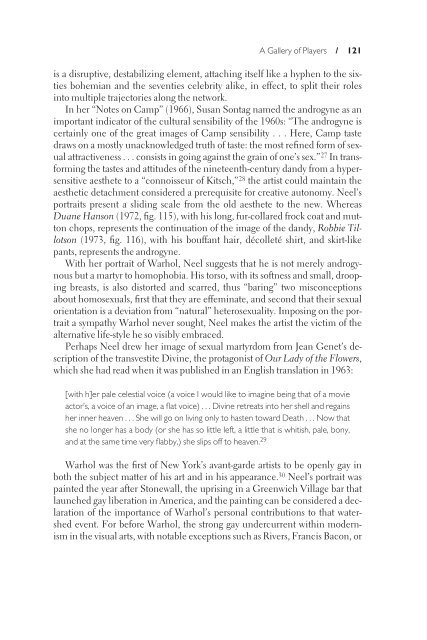i-xxii Front matter.qxd - Brandeis Institutional Repository
i-xxii Front matter.qxd - Brandeis Institutional Repository
i-xxii Front matter.qxd - Brandeis Institutional Repository
Create successful ePaper yourself
Turn your PDF publications into a flip-book with our unique Google optimized e-Paper software.
A Gallery of Players / 121is a disruptive, destabilizing element, attaching itself like a hyphen to the sixtiesbohemian and the seventies celebrity alike, in effect, to split their rolesinto multiple trajectories along the network.In her “Notes on Camp” (1966), Susan Sontag named the androgyne as animportant indicator of the cultural sensibility of the 1960s: “The androgyne iscertainly one of the great images of Camp sensibility . . . Here, Camp tastedraws on a mostly unacknowledged truth of taste: the most reƒned form of sexualattractiveness . . . consists in going against the grain of one’s sex.” 27 In transformingthe tastes and attitudes of the nineteenth-century dandy from a hypersensitiveaesthete to a “connoisseur of Kitsch,” 28 the artist could maintain theaesthetic detachment considered a prerequisite for creative autonomy. Neel’sportraits present a sliding scale from the old aesthete to the new. WhereasDuane Hanson (1972, ƒg. 115), with his long, fur-collared frock coat and muttonchops, represents the continuation of the image of the dandy, Robbie Tillotson(1973, ƒg. 116), with his bouffant hair, décolleté shirt, and skirt-likepants, represents the androgyne.With her portrait of Warhol, Neel suggests that he is not merely androgynousbut a martyr to homophobia. His torso, with its softness and small, droopingbreasts, is also distorted and scarred, thus “baring” two misconceptionsabout homosexuals, ƒrst that they are effeminate, and second that their sexualorientation is a deviation from “natural” heterosexuality. Imposing on the portraita sympathy Warhol never sought, Neel makes the artist the victim of thealternative life-style he so visibly embraced.Perhaps Neel drew her image of sexual martyrdom from Jean Genet’s descriptionof the transvestite Divine, the protagonist of Our Lady of the Flowers,which she had read when it was published in an English translation in 1963:[with h]er pale celestial voice (a voice I would like to imagine being that of a movieactor’s, a voice of an image, a „at voice) . . . Divine retreats into her shell and regainsher inner heaven . . . She will go on living only to hasten toward Death . . . Now thatshe no longer has a body (or she has so little left, a little that is whitish, pale, bony,and at the same time very „abby,) she slips off to heaven. 29Warhol was the ƒrst of New York’s avant-garde artists to be openly gay inboth the subject <strong>matter</strong> of his art and in his appearance. 30 Neel’s portrait waspainted the year after Stonewall, the uprising in a Greenwich Village bar thatlaunched gay liberation in America, and the painting can be considered a declarationof the importance of Warhol’s personal contributions to that watershedevent. For before Warhol, the strong gay undercurrent within modernismin the visual arts, with notable exceptions such as Rivers, Francis Bacon, or
















